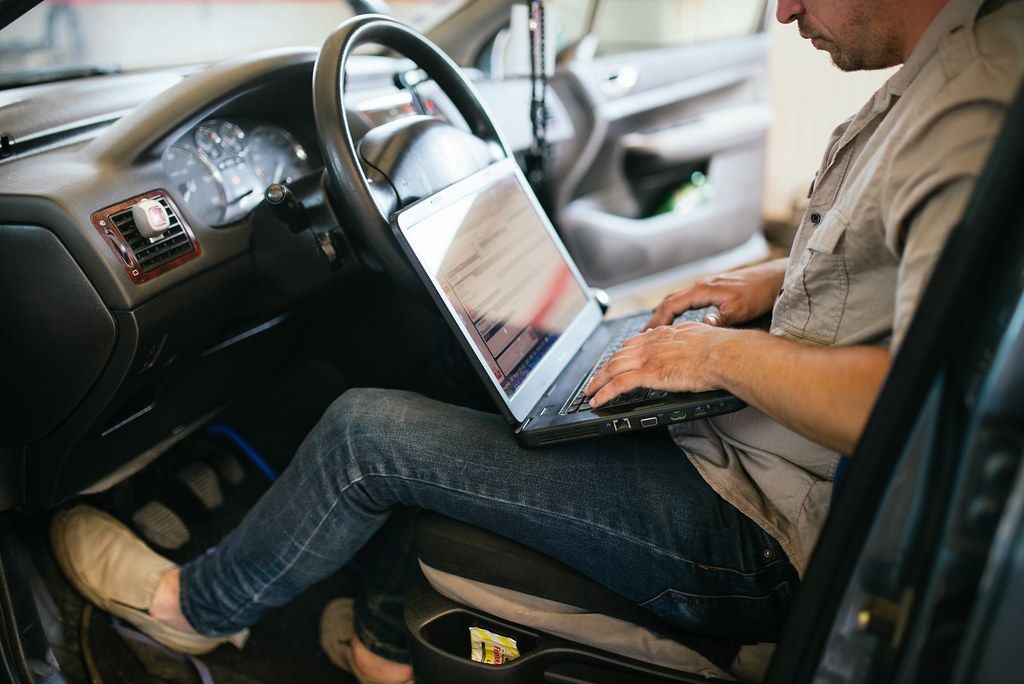Modern vehicles are significantly more complex than their older counterparts, boasting ten times the control units found in cars from the 1990s. This technological leap means that diagnosing car troubles has become more accessible than ever, often starting with simply reading error codes. This is where OBD2 scanners become invaluable tools for car owners.
Learning how to effectively use an OBD2 scanner can save you considerable time and money on car repairs. This guide provides a comprehensive overview of what every driver needs to know about utilizing these diagnostic devices.
Uncover Hidden Issues in Used Cars
Get report
Understanding the Function of an OBD2 Scanner
An OBD2 scanner is a powerful device designed to connect to your car’s onboard computer system via a dedicated port. Once connected, it retrieves a wealth of information from the vehicle’s control units. This data includes diagnostic trouble codes (DTCs), also known as fault codes, and real-time data, often referred to as live data. Live data encompasses various sensor readings throughout the vehicle, such as pressure levels, temperature readings, and speed data.
Source: Flickr / shixart1985
The information gathered by an OBD2 scanner originates from a network of sensors embedded throughout your car. Typically, fault codes are triggered when a sensor reading falls outside of the expected range or if a sensor ceases to respond altogether.
More sophisticated diagnostic tools offer advanced functionalities, including service resets and even module coding. Coding is particularly essential when replacing certain components in contemporary vehicles, ensuring the new part is correctly integrated with the car’s electronic system.
The implementation of on-board diagnostics became mandatory for all vehicles manufactured from 1996 in the United States and from 2004 in Europe, making OBD2 scanners universally applicable to modern cars.
Exploring Different Types of OBD2 Scanners
The market offers a wide array of OBD2 scanners to suit various needs and budgets. The most basic and economical option is a Bluetooth OBD2 code reader. These compact devices pair wirelessly with your smartphone, typically via a dedicated app. Often costing just a small amount, Bluetooth OBD2 readers are capable of reading fault codes and displaying basic live data, making them a user-friendly entry point for the average car owner.
For individuals who are more inclined towards DIY car maintenance and repairs, investing in a more capable, standalone OBD2 scanner is advisable. These scanners, often priced starting around $100 and increasing with added features, offer functionalities beyond basic code reading. They can reset service lights, initiate service procedures necessary for tasks like brake pad replacement, and access a broader spectrum of live data parameters.
While standard OBD2 scanners are suitable for many car owners and DIYers, professional mechanics often require more advanced tools. For professionals, reading fault codes and viewing live data are just the starting points. Professional-grade OBD2 diagnostic tools offer extensive coding and programming capabilities, essential for complex repairs and system adjustments.
With the appropriate professional tools, a skilled automotive technician can fine-tune virtually every configurable option within a modern vehicle’s electronic systems. However, these professional-grade tools can cost thousands of dollars and are generally too complex for the average user.
Step-by-Step Guide: Reading OBD2 Fault Codes
Reading fault codes is the fundamental step in OBD2 diagnostics. Mastering this process is essential if you intend to utilize an OBD2 scanner for car troubleshooting.
While the specific controls and menu layouts may vary across different OBD2 scanner models, the underlying principle for reading fault codes remains consistent.
1. Establish the Scanner Connection
Every modern car is equipped with an OBD2 port. This port is typically located beneath the steering wheel, often within the driver’s side footwell area, or sometimes in the center console. The OBD2 port may be concealed by a small plastic cover, so you might need to locate and open this cover before you can plug in your OBD2 scanner.
Source: carVertical
Many contemporary scanners and code readers utilize Bluetooth technology for wireless communication. If you are using a Bluetooth scanner, ensure it is properly paired with your smartphone or device according to the manufacturer’s instructions.
2. Power On the Ignition
Computer diagnostics via an OBD2 scanner require the car’s ignition to be switched on. Before initiating a scan, turn the car’s ignition to the “ON” position. This provides power to the car’s computer systems and the OBD2 port. To minimize battery drain during the diagnostic process, it is advisable to turn off unnecessary electrical loads such as headlights, the radio, and the air conditioning system.
While some vehicles allow fault code scanning with the engine running, it is generally recommended to perform the initial scan with just the ignition on. Fault codes are stored in the car’s computer memory and will persist until they are intentionally cleared, regardless of whether the engine is running. Starting the engine might be useful later when observing live data readings, as certain sensor values are only generated when the engine is operating.
3. Input Vehicle Details
Once your OBD2 scanner is connected and the ignition is on, you will typically need to input your vehicle’s information into the scanner. This usually involves selecting the car’s make, model, and year. This information is crucial for the scanner to correctly identify the car’s control units and accurately interpret the data it retrieves.
Many modern diagnostic tools are equipped with an automatic VIN recognition feature. This system automatically detects the car’s Vehicle Identification Number (VIN) and uses it to automatically configure the necessary vehicle specifications within the scanner. In cases where automatic VIN recognition is unsuccessful, you can manually enter the VIN into the scanner.
4. Initiate Fault Code Scan
After vehicle identification is complete, navigate the scanner’s menu to find the option for reading fault codes. Most scanners offer the choice to scan specific control units individually or to perform a comprehensive scan of all available control units.
If you are unsure how to locate these scan options within your specific scanner’s interface, consult the scanner’s integrated help section or refer to the user manual provided by the manufacturer.
The duration of a full system scan can vary depending on the car model and the complexity of its electronic systems, typically ranging from a few seconds to several minutes.
5. Analyze the Displayed Fault Codes
The fault codes displayed after a scan are the key indicators of potential issues triggering warning lights on your car’s dashboard instrument cluster. Sometimes, fault codes can be quite descriptive and straightforward. For example, a code like “C0031- Right Front Wheel Speed Sensor Circuit” clearly points to a problem with the right front wheel speed sensor or its circuit. In such cases, the fault code directly suggests the component requiring attention.
However, it is crucial to understand that the underlying causes behind fault codes are often more intricate than they initially appear. For instance, a common fault code “P0171 – System Too Lean (Bank 1)” indicates that the engine’s air-fuel mixture is too lean. While the code identifies the symptom, the root cause could be a variety of issues. Potential causes for a P0171 code can range from a simple clogged fuel filter or a failing fuel pump to a vacuum leak in the intake system or malfunctions in various sensors, among other possibilities.
Pro Tip: Utilizing Live Data for Enhanced Diagnostics
The capability to access and interpret live data significantly enhances the diagnostic power of an OBD2 scanner. Most control units within a car provide a live data stream, allowing you to monitor real-time sensor readings and system parameters. How can live data aid in troubleshooting?
Consider a scenario where your car is exhibiting reduced engine power, and the only fault code present is related to “limp mode” or reduced performance. In this situation, examining live data can be invaluable. You could monitor parameters such as fuel pressure, turbocharger boost pressure (if applicable), intake air flow readings, and intake manifold pressure to check if these values are within their normal operating ranges. Deviations from expected live data readings can provide critical clues in pinpointing the source of the performance issue.
Source: Flickr / comedy_nose
While OBD2 scanners provide access to valuable diagnostic information, interpreting fault codes and effectively utilizing live data may sometimes require further expertise and automotive knowledge.
OBD2 Scanners: Essential for Used Car Inspections
The used car market can present potential pitfalls for buyers. Unscrupulous sellers may attempt to sell vehicles with undisclosed issues, ranging from hidden accident history to electrical problems or even legal encumbrances.
While obtaining a vehicle history report is a crucial step in used car due diligence, a thorough pre-purchase inspection is paramount to avoid unexpected and costly repairs down the line.
Before finalizing the purchase of a used vehicle, it is always recommended to obtain a vehicle history report and, crucially, to use an OBD2 scanner to check for stored fault codes. If you do not own an OBD2 scanner or are unfamiliar with its operation, it is a wise investment to have the car inspected by a qualified professional mechanic.
Verify Vehicle History
Protect yourself from future expenses by checking the background of a used car. Get your vehicle history report instantly!
Clearing Fault Codes: When and How
Scanning for fault codes is a diagnostic step, and the codes themselves often do not directly pinpoint the exact problem. Even when a diagnostic scan indicates a faulty mass airflow (MAF) sensor, experienced automotive technicians typically perform further tests using a multimeter to confirm the sensor’s malfunction before replacing it. This practice helps prevent misdiagnosis and unnecessary parts replacement. Fault codes can sometimes be triggered by issues such as damaged wiring, loose electrical connections, or corrosion, rather than a faulty sensor itself.
Once the underlying problem has been identified and repaired, it is essential to re-scan for fault codes. If the original fault code no longer reappears after the repair, it is a strong indication that the issue has been successfully resolved, and the vehicle is ready to be driven.
Frequently Asked Questions
Article by
Evaldas Zabitis
Evaldas’s passion for cars started early, leading him to spend his time fixing, driving, and trading cars. He actively follows automotive technology advancements and participates in car enthusiast communities.

